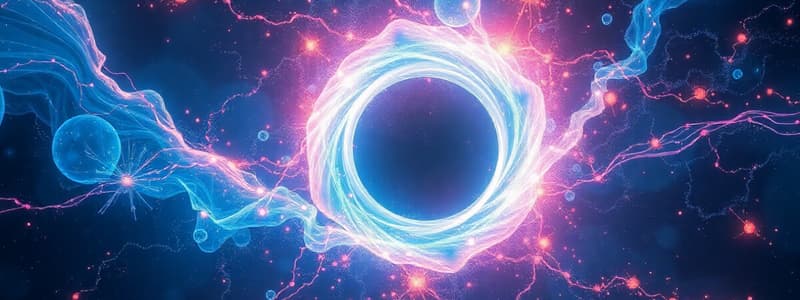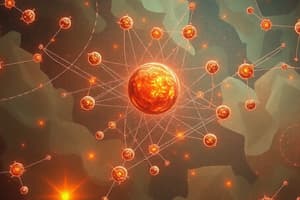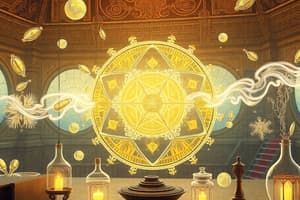Podcast
Questions and Answers
What is the complete symbol for Americium-241?
What is the complete symbol for Americium-241?
- Am-241 (correct)
- 241Am (correct)
- Am241
- 241Am-3
How many protons are present in a lithium atom?
How many protons are present in a lithium atom?
- 2
- 4
- 5
- 3 (correct)
Which of the following correctly describes a molecule?
Which of the following correctly describes a molecule?
- A single atom of an element
- A group of elemental symbols
- A combination of two or more atoms bonded together (correct)
- An ionic compound
What is the molecular formula for hydrogen gas?
What is the molecular formula for hydrogen gas?
What is the molecular formula for the molecule that consists of 8 sulfur atoms?
What is the molecular formula for the molecule that consists of 8 sulfur atoms?
Which element has the atomic symbol 'Si'?
Which element has the atomic symbol 'Si'?
To name a molecule based on its formula, you should first identify what?
To name a molecule based on its formula, you should first identify what?
How many neutrons does a potassium atom contain?
How many neutrons does a potassium atom contain?
What prefix is used to indicate four atoms of an element in a molecular formula?
What prefix is used to indicate four atoms of an element in a molecular formula?
Which of the following is the correct name for the molecule P2S5?
Which of the following is the correct name for the molecule P2S5?
What is the correct formula for carbon tetrachloride?
What is the correct formula for carbon tetrachloride?
Which of the following names uses the correct prefix for three atoms?
Which of the following names uses the correct prefix for three atoms?
What would be the correct name for SO3?
What would be the correct name for SO3?
What is the correct way to name the compound with the formula SF4?
What is the correct way to name the compound with the formula SF4?
Which prefix would be used for six atoms of an element?
Which prefix would be used for six atoms of an element?
What is the correct chemical formula for silicon dioxide?
What is the correct chemical formula for silicon dioxide?
What is known as the smallest piece of an element that maintains its identity?
What is known as the smallest piece of an element that maintains its identity?
What does the atomic number represent in an atom?
What does the atomic number represent in an atom?
Isotopes of the same element differ in the number of which subatomic particles?
Isotopes of the same element differ in the number of which subatomic particles?
What is the mass number of an atom with 6 protons and 6 neutrons?
What is the mass number of an atom with 6 protons and 6 neutrons?
What is the correct representation of a carbon atom with 6 protons and 6 neutrons?
What is the correct representation of a carbon atom with 6 protons and 6 neutrons?
An atom of uranium with an atomic number of 92 and a mass number of 235 contains how many neutrons?
An atom of uranium with an atomic number of 92 and a mass number of 235 contains how many neutrons?
What is the mass number of a tin atom that has 50 protons and 68 neutrons?
What is the mass number of a tin atom that has 50 protons and 68 neutrons?
Which of the following is an appropriate symbol for an isotope of aluminum with an atomic number of 13 and mass number of 27?
Which of the following is an appropriate symbol for an isotope of aluminum with an atomic number of 13 and mass number of 27?
Flashcards
Atom
Atom
The smallest piece of an element that retains its identity.
Subatomic Particles
Subatomic Particles
Particles that make up an atom, such as protons, neutrons, and electrons.
Atomic Number
Atomic Number
Number of protons in the nucleus of an atom; unique to each element.
Isotopes
Isotopes
Signup and view all the flashcards
Mass Number
Mass Number
Signup and view all the flashcards
Atomic Symbol
Atomic Symbol
Signup and view all the flashcards
Protons
Protons
Signup and view all the flashcards
Neutrons
Neutrons
Signup and view all the flashcards
Molecule
Molecule
Signup and view all the flashcards
Molecular Formula
Molecular Formula
Signup and view all the flashcards
Chemical Bond
Chemical Bond
Signup and view all the flashcards
Americium-241
Americium-241
Signup and view all the flashcards
Carbon-14
Carbon-14
Signup and view all the flashcards
Rules of Chemical Nomenclature
Rules of Chemical Nomenclature
Signup and view all the flashcards
Prefixes for Molecules
Prefixes for Molecules
Signup and view all the flashcards
Prefix for 5 atoms
Prefix for 5 atoms
Signup and view all the flashcards
Prefix for 6 atoms
Prefix for 6 atoms
Signup and view all the flashcards
Naming second element
Naming second element
Signup and view all the flashcards
Example: Nitrogen Trichloride
Example: Nitrogen Trichloride
Signup and view all the flashcards
Drop 'a' or 'o' in prefixes
Drop 'a' or 'o' in prefixes
Signup and view all the flashcards
Formula for Carbon Tetrachloride
Formula for Carbon Tetrachloride
Signup and view all the flashcards
Example: P2S5
Example: P2S5
Signup and view all the flashcards
Study Notes
Atomic Theory
- Atoms are the smallest unit of an element, maintaining its identity.
- The term "atom" comes from a Greek word meaning "indivisible."
- Atoms are composed of subatomic particles.
Modern Atomic Theory
- All matter is composed of atoms.
- Atoms of the same element are identical; atoms of different elements are different.
- Atoms combine in whole-number ratios to form compounds.
The Atom
- Protons: Located in the nucleus; have a positive charge (1+) and a mass of approximately 1.6 × 10-27 kg.
- Neutrons: Located in the nucleus; have no charge and a mass of approximately 1.6 × 10-27 kg.
- Electrons: Orbit the nucleus; have a negative charge (1-) and a mass of approximately 9.1 × 10-31 kg.
Atomic Number
- The number of protons in an atom's nucleus defines the atomic number.
- All atoms of the same element have the same atomic number.
- However, atoms of the same element can have different numbers of neutrons.
Isotopes
- Atoms of the same element with different numbers of neutrons are called isotopes.
- The mass number is the sum of protons and neutrons in an atom's nucleus.
Atomic Symbols
- Atomic symbols use the element's symbol followed by the mass number (protons + neutrons).
- Example: Carbon-12 (12C) represents an isotope of carbon with 6 protons and 6 neutrons.
Periodic Table of Elements
- Organized by increasing atomic number.
- Elements' properties are related to their position on the table.
- Elements are categorized as metals, metalloids, and nonmetals.
Molecules and Chemical Nomenclature
- Molecules: Two or more atoms bonded strongly, behaving as a single particle.
- Molecular Formula: A written representation of the number and type of atoms in a molecule. Example: H2 (two hydrogen atoms).
- Chemical Nomenclature: Rules for naming compounds.
Rules of Chemical Nomenclature
- Identify the elements in the compound.
- Start with the first element's name, using prefixes (e.g., mono-, di-, tri-) for additional atoms if needed.
- Name the second element, incorporating prefixes (if needed) and changing its ending to "-ide."
- Combine the names. Example: carbon dioxide (CO2)
- Specific rules apply when prefixes end in "a" or "o" and the second element begins with a vowel. e.g. monoxide, pentoxide.
Studying That Suits You
Use AI to generate personalized quizzes and flashcards to suit your learning preferences.




